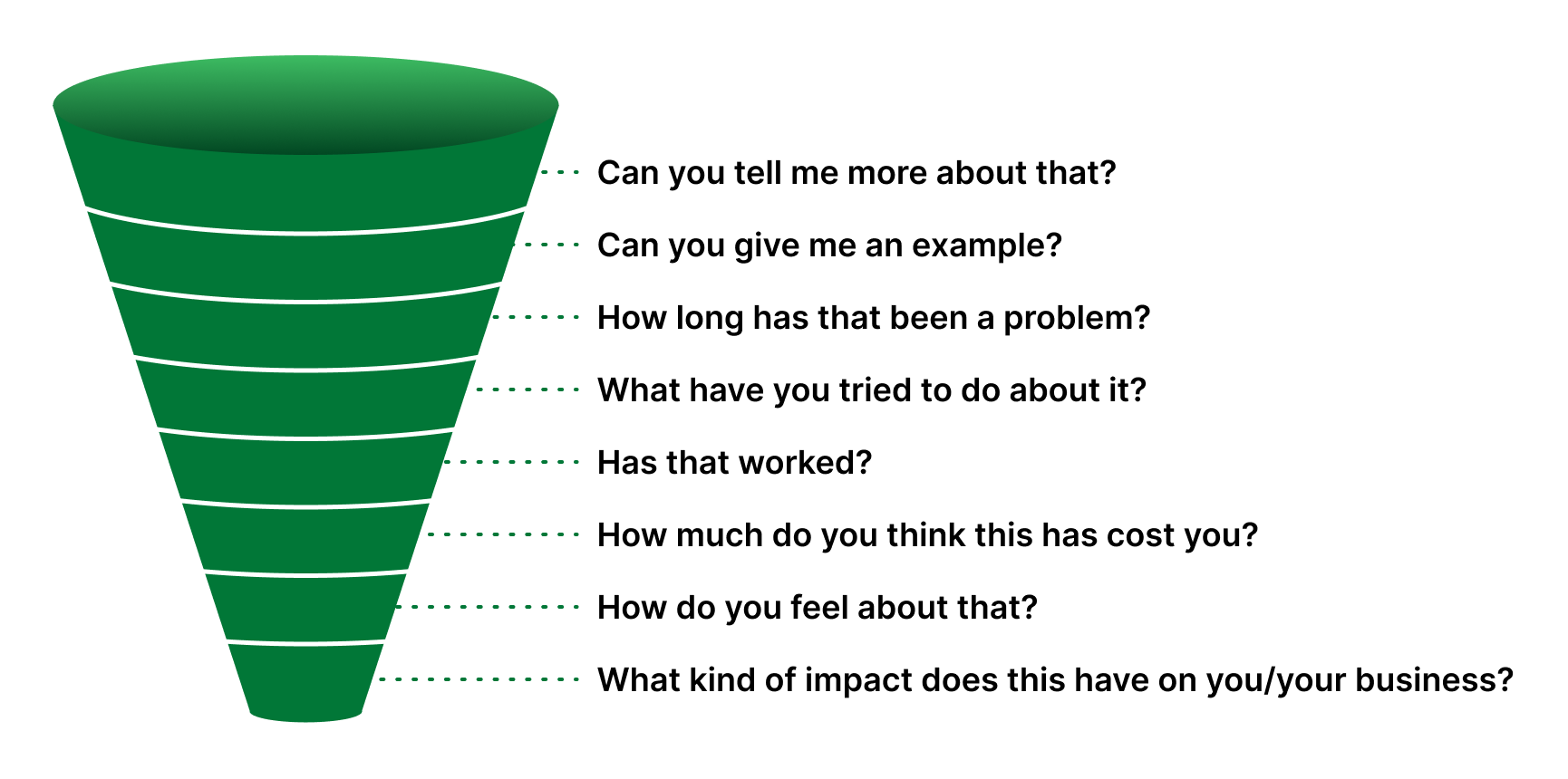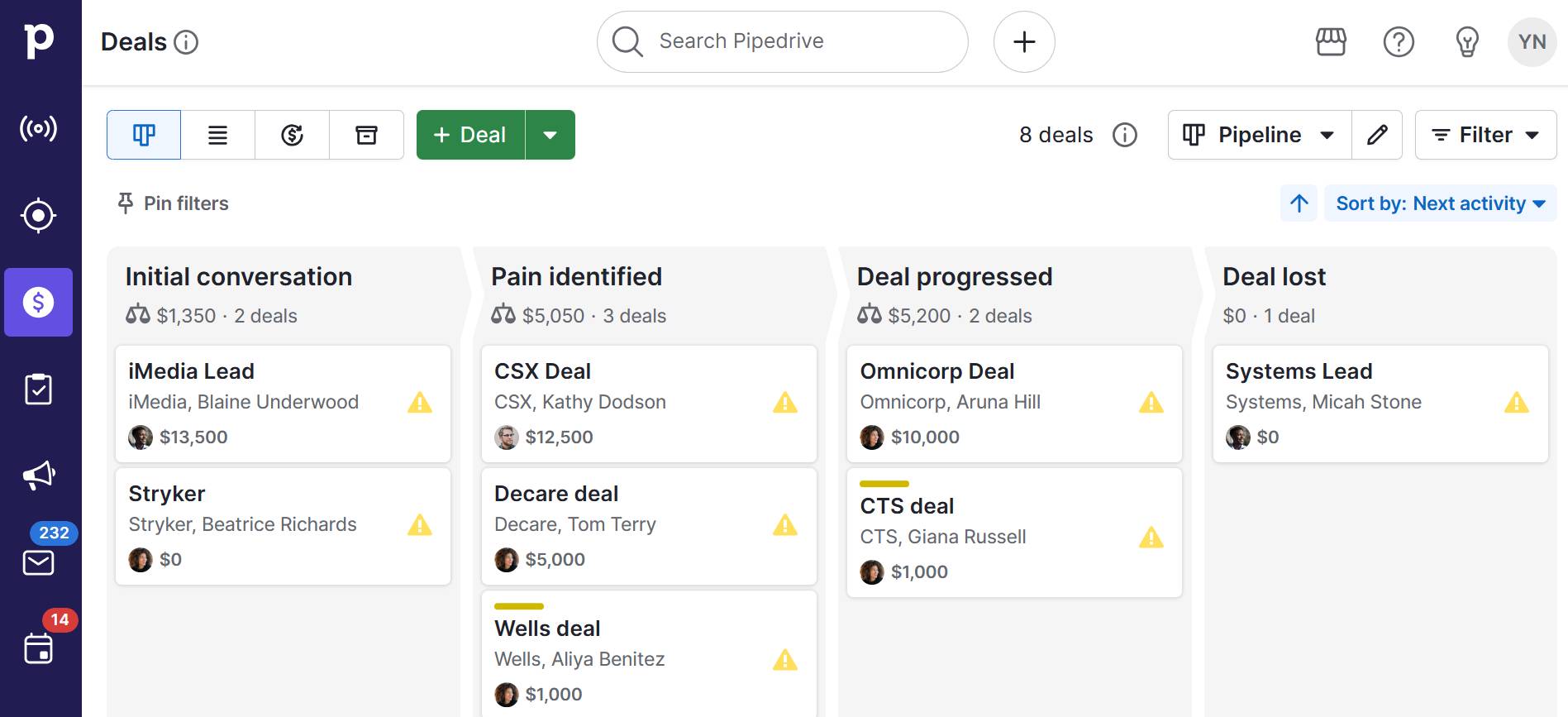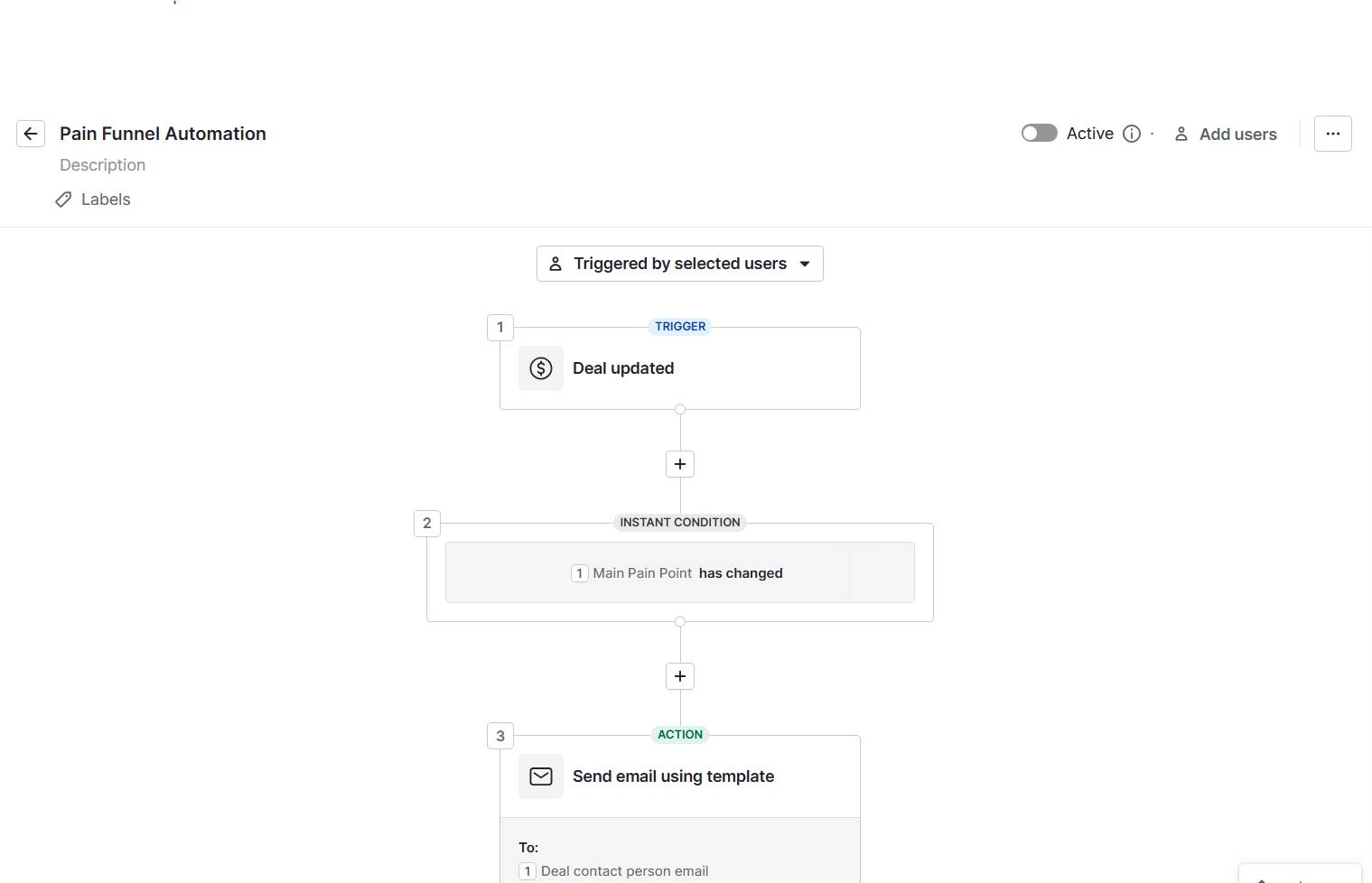Many sales calls lose momentum when potential customers can’t explain what’s really holding them back.
The Sandler pain funnel uses open-ended questions to uncover pain points, making it easier for salespeople to understand a customer’s current situation and build trust.
In this article, you’ll learn how the pain funnel works and the best questions to ask. You’ll also learn how the pain funnel compares to other sales methods and how to use it in your CRM to close more deals.
Key takeaways for pain funnel
The Sandler pain funnel is a selling method that helps salespeople and business development teams identify genuine customer pain points.
It uses structured questions to build trust, improve discovery and find solutions that are more relevant to prospects.
The pain funnel is one of several sales methodologies that can be used together to create a balanced and flexible sales strategy.
Pipedrive makes it easy to capture pain points and act on them consistently. Try it free for 14 days.
What is the Sandler pain funnel?
The Sandler pain funnel is a sales tactic that helps salespeople uncover a prospect’s real challenges by asking a series of open-ended questions.
The approach is based on the Sandler Selling System, a methodology developed by David Sandler in the late 1960s to replace high-pressure sales strategies with trust-based conversations.
Instead of rushing prospects to a sales pitch, the funnel guides the conversation further, moving from surface-level symptoms to the true pain a customer feels.

For example, imagine an HR software company talking with a prospect. At first, the prospect says their current system is “a bit slow”.
Using the pain funnel, the rep asks follow-up questions. Soon, the prospect shares that slow reporting causes payroll errors and employee frustration, which takes hours to fix each month.
By slowing down and asking specific questions, sales development reps create space for potential customers to explain the emotional and financial impact of their problems.
The goal is to connect with the customer on a deeper level and position your solution as the right fit.
8 classic Sandler pain funnel questions
The pain funnel works because it guides sales communication step by step, helping salespeople move from superficial problems to the true pain that drives decisions.
Let’s take a look at eight of the most common pain funnel questions below.
Sandler pain funnel question | Purpose |
1. Can you tell me more about that? | Encourages elaboration instead of short, closed answers. |
2. Can you give me an example? | Moves from abstract statements to specific, concrete situations. |
3. How long has that been a problem? | Reveals the history and urgency behind the issue. |
4. What have you tried to do about it? | Reveals attempts already made and what hasn’t worked. |
5. Has that worked? | Clarifies effectiveness and sets up the case for change. |
6. How much do you think this has cost you? | Quantifies financial or resource impact, framing ROI. |
7. How do you feel about that? | Taps into the emotional impact of the problem, building urgency. |
8. What kind of impact does this have on you/your business? | Connects the problem to broader consequences and decision-making. |
As you can see, each question in the Sandler pain funnel has a clear role in uncovering customers’ pain points.
When used together, they create a natural flow that helps prospects move from describing surface frustrations to revealing the emotional and financial impact of their situation.
What are the pros and cons of the Sandler pain funnel?
Many sales professionals value the Sandler pain funnel’s ability to uncover true pain points, but this approach also has drawbacks if it’s not used with care.
Understanding the pros and potential cons will help your sales team apply the methodology effectively and avoid common mistakes.
Pros of the Sandler pain funnel
Salespeople who use the pain funnel point to its ability to make conversations more meaningful.
Some of the main benefits include:
Establishing a deep understanding of client needs. By uncovering root causes and connecting to real business challenges, reps can find more applicable solutions.
Building trust and rapport. Asking thoughtful discovery questions and listening closely shows genuine interest, making prospects feel valued.
Differentiating your company from competitors. Personalized discovery enables reps to stand out from generic pitches and position their solution as the better fit.
These advantages make the Sandler pain funnel a practical sales technique for building stronger connections with sales prospects.
Cons of the Sandler pain funnel (and how to avoid them)
According to some sales reps, the pain funnel can slow down the B2B sales process or even create discomfort for potential customers. Common challenges include:
Perceived manipulation. Avoid coming across as scripted by asking follow-up questions that build on what the prospect just said.
Salesperson discomfort. If probing questions feel too direct, soften them with permission statements such as “Would it be okay if I asked about [X]?” or “Can we explore that a bit more?”
Client resistance. Pay attention to tone and pacing and weave pain funnel questions naturally into your regular discovery process so it feels conversational rather than structured.
In practice, the pain funnel is most effective when sales teams strike a balance between technique and authenticity.
Adapt your style to the prospect’s comfort level and weave questions into the conversation naturally to achieve the best results.
Seal More Deals With Your Free Sales Communication Handbook
Sandler vs. other qualification frameworks
The Sandler pain funnel isn’t the only sales methodology designed to uncover customer needs.
Sales professionals should understand how it compares with other frameworks so they can choose the right approach for each sales conversation – or even blend techniques for better results.
Here are some of the most common sales techniques used today.
Sandler vs. SPIN selling
SPIN selling is designed to guide prospects from describing their situation to recognizing the need for change.
It’s built around four types of questions:
Situation. Establishes context about the prospect’s current setup or process.
Problem. Surfaces challenges or frustrations within that situation.
Implication. Explores the consequences of leaving the problem unresolved.
Need-payoff. Highlights the benefits of solving the problem with the proposed solution.
This methodology helps salespeople guide prospects from describing their current situation to recognizing the value of change.
The video below gives a more in-depth explanation of SPIN selling.
What’s the difference? SPIN focuses on a structured sequence of questions across four categories. The Sandler pain funnel drills deeper into one problem through progressive layers of discovery.
Sandler emphasizes emotional impact and true pain, whereas SPIN frames the problem logically and highlights benefits.
Example: A consulting company speaking with a prospect about project delays.
Using the pain funnel, the rep might ask, “How long has that been a problem?” and “How do you feel about the impact on your team?”
With SPIN, the rep would ask about:
- The current workflow (Situation)
- Explore the bottleneck (Problem)
- Highlight consequences of delays (Implication)
- Then show how consulting support could resolve it (Need-payoff)
Both methods uncover value, but one leans on emotional urgency while the other builds a rational case.
Sandler vs. BANT
BANT helps salespeople quickly determine if a prospect is worth pursuing.
It centers on four criteria:
Budget. Does the prospect have the money to invest in your solution?
Authority. Does the person you’re speaking with have the power to make the decision?
Need. Does the prospect actually require what you’re offering?
Timing. Is there urgency or a defined timeline for solving the problem?
This qualification framework helps sales reps qualify leads early in the sales process and focus efforts on opportunities most likely to close.
The podcast episode below covers both BANT and MEDICC sales methods.
What’s the difference? BANT is a filtering tool that ensures prospects meet basic conditions. The Sandler pain funnel digs into the customer’s true pain points and emotional drivers.
Sandler emphasizes discovery and connection, whereas BANT emphasizes efficiency and lead qualification.
Example: An agency meeting with a manufacturer interested in process improvement.
Using the pain funnel, the rep might explore how delays make the prospect feel and how the issue affects team morale.
With BANT, the rep would check if:
- The company has the budget to hire consultants (Budget)
- Confirm who signs off on contracts (Authority)
- Validate that the project delays are a real problem (Need)
- Ask if they want to solve it this quarter or later (Timing)
Both methods serve different purposes. BANT qualifies the lead and Sandler uncovers the depth of the problem.
Sandler vs. MEDDICC
The MEDDICC sales process is used in complex B2B sales cycles to ensure opportunities are thoroughly vetted. It focuses on:
Metrics. What measurable results does the prospect expect?
Economic buyer. Who controls the budget?
Decision criteria. What factors influence the final decision?
Decision process. How will the decision be made and approved?
Identify pain. What specific problems need solving?
Champion. Who inside the prospect’s company supports your solution?
Competition. Who else is the prospect considering?
This methodology enables salespeople to build a detailed picture of the opportunity and tailor their pitch to the customer’s buying process.
The video below gives an in-depth look at MEDDICC.
What’s the difference? MEDDICC is a structured checklist for qualifying deals and reducing risk in enterprise sales. The Sandler pain funnel, by contrast, focuses less on organizational mechanics and more on uncovering emotional pain and urgency.
Sandler delves into the human side of the problem, while MEDDICC ensures that a deal can be realistically closed.
Example: An IT company speaking with a global healthcare provider about upgrading its network security.
With the pain funnel, the rep might ask, “How long has this been affecting your operations?” or, “How do you feel about the risks of downtime for your staff?” to uncover urgency and frustration.
With MEDDICC, the rep would:
- Quantify expected savings or risk reduction (Metrics)
- Identify who approves IT budgets (Economic buyer)
- Understand what matters most in the buying decision (Decision criteria)
- Map out the approval steps (Decision process)
- Find a champion inside IT leadership (Champion)
- Assess competing vendors (Competition)
Sandler determines urgency to act, while MEDDICC tests the deal’s viability.
Pipedrive in action: Combat Ready, a UK training consultancy, used Pipedrive to streamline its sales process and track client interactions more effectively. As a result, the team increased efficiency and gained better visibility into its deals and client needs. “It’s 100 million times more efficient than Excel”, says Remo Ojaste, CEO of Combat Ready.
Real-world examples and scripts you can adapt
The pain funnel is most effective when applied in real sales conversations.
Small and mid-size businesses (SMBs) can benefit by using the funnel to uncover hidden issues and connect solutions to customer needs.
Below are examples of how sales reps in three different industries can use pain funnel questions.
1. Financial advising
A financial advisor meets with a small business owner who mentions feeling “uncertain” about retirement planning.
Instead of jumping into a sales pitch, the advisor uses pain funnel questions to guide the conversation:
Rep: “Can you tell me more about that uncertainty?”
Prospect: “I’m not sure if our current plan is competitive enough to keep employees happy.”
Rep: “Can you give me an example?”
Prospect: “One of our senior designers asked how our 401(k) compares to what larger agencies offer, and I didn’t have a clear answer.”
Rep: “How long has that been a concern for you?”
Prospect: “Since we started hiring more senior staff, who expect stronger benefits.”
Rep: “What kind of impact does that have on your ability to attract or retain talent?”
Prospect: “It worries me that we could lose people if our benefits don’t measure up, which would slow down client projects.”
By the end of the exchange, the advisor has uncovered the true pain: the business risk of losing talent due to weak benefits.
Instead of focusing only on financial products, the advisor can position their services as a way to strengthen the agency’s employee value proposition, helping the owner compete for talent and grow the business.
Tip: A summary loop is a conversational technique where the salesperson pauses to restate what the prospect has just said, then checks for confirmation. Use this technique to show that you’ve been actively listening and help build customer trust in sensitive conversations about finances.
2. Catering management software
A catering management software provider meets with the owner of a mid-size catering company that handles weddings and corporate events.
The owner mentions that “operations feel messy” during busy seasons.
Rather than diving into a sales demo, the rep uses the pain funnel to explore the issue:
Rep: “Can you tell me more about what you mean by messy?”
Prospect: “We sometimes double-book staff or forget to update last-minute menu changes in the system.”
Rep: “Can you give me an example?”
Prospect: “At a corporate event last month, the team showed up with the wrong menu version and we had to scramble to fix it.”
Rep: “How long has this been a problem?”
Prospect: “Honestly, it’s been happening for years, but it’s gotten worse as we’ve added more clients.”
Rep: “What kind of impact does that have on your business?”
Prospect: “It hurts our reputation and I’m worried it could cost us repeat business with big accounts.
Through these questions, the rep uncovers that the real pain isn’t just operational inefficiency but the risk of damaging client relationships.
With that understanding, the rep can demonstrate how the software helps standardize workflows, reduce errors and protect the company’s brand reputation.
Tip: Aim for a talk-to-listen ratio of about 40/60. Gong research shows top sellers consistently stay near this balance, while low performers drift up to 10% higher or lower, either talking too much or not enough.
3. Commercial real estate
A commercial real estate broker meets with the CFO of a growing logistics company that is considering moving into a larger warehouse.
The CFO says their “current space is starting to feel tight”.
Instead of rushing to show properties, the broker leans into the later stages of the pain funnel:
Rep: “What have you tried to do about the space issue so far?”
Prospect: “We’ve rearranged the floor and added temporary storage, but it’s still crowded.”
Rep: “Has that worked?”
Prospect: “Not really. It buys us a little time, but our shipping volumes keep growing.”
Rep: “How much do you think this has cost you in terms of efficiency or missed opportunities?”
Prospect: “It’s hard to say exactly, but delays in packing and shipping probably cost us thousands every quarter.”
Rep: “How do you feel about that impact on your business?”
Prospect: “It’s frustrating because we’re losing money even while demand is strong.”
By using these more probing questions, the broker uncovers that the true pain is not just cramped space but the financial and emotional strain of losing revenue opportunities.
This positions the broker to recommend a new warehouse solution as an investment to unlock growth.
Tip: Use permission statements before asking deeper pain questions. For example, “Would it be okay if I asked about the costs tied to these delays?” These kinds of statements make the conversation feel collaborative and reduce resistance when exploring sensitive topics.
How to implement pain funnel feedback with Pipedrive
A good sales CRM like Pipedrive can help your team capture customer needs during discovery and follow up with the right actions at the right time.
Pipedrive is built to help small and mid-size businesses manage leads, track deals and automate workflows. Below are some ways you can use it to implement your pain funnel feedback.
Build a discovery-friendly pipeline
Pipedrive’s pipeline management tool makes it simple to align your sales process with the pain funnel.
By creating stages that reflect a prospect’s progress in the discovery process, reps can move deals forward only after true pain has been identified.
Customized stages give sales managers visibility into whether customer needs have been identified before advancing the deal.
Actionable steps:
Create a pipeline in Pipedrive dedicated to early discovery and qualification
Define stages such as “Initial conversation” and “Pain identified” to capture progress
Add clear criteria for advancing a deal so reps confirm a prospect’s pain points before moving forward

A discovery-friendly pipeline provides reps with a clear structure for asking the right questions and helps managers identify which opportunities are truly ready to progress.
Use custom fields to capture pain consistently
Custom fields in Pipedrive enable sales reps to record details linked directly to pain funnel questions, such as financial impact or emotional concerns.
Instead of leaving insights buried in long notes, reps can capture them in a structured format that’s easy to review and report on.
This structure ensures consistency in discovery across the team and makes customer pain points visible throughout the sales process.
Actionable steps:
Go to “Settings > Data Fields > Add Custom Field”
Create fields like “Main pain point” or “Impact on business”
Train reps to complete these fields right after each discovery call

A clear set of custom fields turns subjective notes into actionable data that supports better follow-up and decision-making.
Automate follow-ups and tasks with Workflow Automation
Pipedrive’s Workflow Automation feature allows reps to set up automatic reminders and tasks based on what they learn during discovery.
Here’s a video overview of how to get started with automations in Pipedrive:
If a pain point is logged, the system can create a follow-up activity or trigger a personalized email without extra admin work.
Automation ensures that prospects feel heard and keeps sales reps focused on solving customer needs, rather than on remembering manual tasks.
Actionable steps:
Open “Workflow Automation” in Pipedrive
Set a trigger for when a deal is updated with a new pain point
Create an automation that schedules a follow-up call or sends a tailored message

With automation in place, teams can maintain momentum in the sales process and build trust through timely, relevant outreach.
Final thoughts
The Sandler pain funnel is a method for building trust and uncovering what truly matters to potential customers.
When used thoughtfully, the pain funnel strengthens sales conversations and sets the stage for solutions that feel relevant and personal. It works best when combined with other sales methodologies and supported by sales coaching that helps reps apply the technique naturally.
With the right tools, you can integrate the pain funnel into your daily sales process and set your team up for lasting sales success.
Pipedrive gives your team a simple way to capture pain points, follow up at the right time and track results across the sales pipeline. Try Pipedrive free for 14 days.






